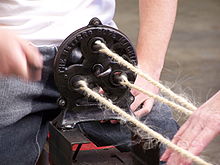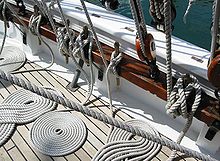Knots/Rope

A rope is a length of fibres, twisted or braided together to improve strength for pulling and connecting. It has tensile strength but is too flexible to provide compressive strength (it can be used for pulling, but not pushing). Rope is thicker and stronger than similarly constructed cord, line, string, or twine.
Construction[edit | edit source]
Common materials for rope include Natural fibres such as Manila hemp, hemp, linen, cotton, coir, jute, and sisal.
Synthetic fibres include polypropylene, nylon, polyesters (e.g. PET, LCP, HPE, Vectran), polyethylene (e.g. Spectra), aramids (e.g. Twaron, Technora and Kevlar) and polyaramids (eg Dralon, Tiptolon). Some ropes are constructed of mixtures of several fibres or use co-polymer fibres.
Styles of rope construction[edit | edit source]
Laid or twisted rope[edit | edit source]
Laid rope, also called twisted rope, is historically the prevalent form of rope, at least in modern Western history. Most twisted rope consists of three strands and is normally right-laid, or given a right-handed twist. Typically, a three strand laid rope is called a plain or hawser-laid rope. A four strand rope is usually called shroud-laid, and a rope twisted out of 3 or more ropes is called cable-laid.

Twisted ropes are built up in three steps. First, fibers are gathered and spun to form yarns. A number of these yarns are then twisted together to form strands. The strands are then twisted together to form the rope. The twist of the yarn is opposite to that of the strand, and that in turn is opposite to that of the rope. This counter-twisting helps keep the rope together. On the other hand, rope constructed in this manner untwists under tension, which is the cause of spinning, kinking, hockling and stretching. Any rope of this type must be bound at its end by some means to prevent untwisting. Twisted ropes have a preferred direction for coiling. Normal right laid rope should be coiled with the sun, or clockwise, to prevent kinking. Coiling this way imparts a twist to the rope. One of the drawbacks of this construction is that every fiber is exposed to abrasion numerous times along the length of the rope. This means that the rope can degrade to numerous inch-long fiber fragments, which is not easily detected visually.
Braided rope[edit | edit source]

Braided ropes are generally made from nylon, polyester or polypropylene. Nylon is chosen for its elastic stretch properties and good resistance to ultraviolet light. Polyester is about 90% as strong as nylon but stretches less under load, is more abrasion resistant, has better UV resistance, and has less change in length when wet. Polypropylene is preferred for low cost and light weight (it floats on water).
Single braid consists of even number of strands, eight or twelve being typical, braided into a circular pattern with half of the strands going clockwise and the other half going anticlockwise. The strands can interlock with either twill or plain weave. The central void may large or small; in the former case the term hollow braid is sometimes preferred. Double braid, also called braid on braid, consists of an inner braid filling the central void in an outer braid, that may be of the same or different material. Often the inner braid fiber is chosen for strength while the outer braid fiber is chosen for abrasion resistance. In solid braid the strands all travel the same direction, clockwise or anticlockwise, and alternate between forming the outside of the rope and the interior of the rope. This construction is popular for general purpose utility rope but rare in specialized high performance line.
Kernmantle rope has a core (kern) of long twisted fibers in the center, with a braided outer sheath or mantle of woven fibers. The kern provides most of the strength (about 70%), while the mantle protects the kern and determines the handling properties of the rope (how easy it is to hold, to tie knots in, and so on). In dynamic climbing line, the core fibers are usually twisted, and chopped into shorter lengths which makes the rope more stretchy. Static kernmantle ropes are made with untwisted core fibers and tighter braid, which causes them to be stiffer in addition to limiting the stretch.
Braided ropes (and objects like garden hoses, fiber optic or coaxial cables, etc.) that have no lay, or inherent twist, will uncoil better if coiled into figure-8 coils, where the twist reverses regularly and essentially cancels out.
Other types[edit | edit source]
Plaited rope is made by braiding twisted strands, and is also called square braid. It is not as round as twisted rope and coarser to the touch. It is less prone to kinking than twisted rope and, depending on the material, very flexible and therefore easy to handle and knot. This construction exposes all fibers as well, with the same drawbacks as described above. Brait rope is a combination of braided and plaited, a non-rotating alternative to laid three-strand ropes. Due to its excellent energy-absorption characteristics, it is often used by arborists. It is also the most popular rope for anchoring and can be used as mooring warps. This type of construction was pioneered by Yale Cordage.
Handling rope[edit | edit source]

Rope made from hemp, cotton or nylon is generally stored in a cool dry place for proper storage. To prevent kinking it is usually coiled. To prevent fraying or unraveling, the ends of a rope are bound with twine, tape, or heat shrink tubing. The ends of plastic fiber ropes are often melted and fused solid.
If a load-bearing rope gets a sharp or sudden jolt or the rope shows signs of deteriorating, it is recommended that the rope be replaced immediately and should be discarded or only used for non-load-bearing tasks.
Line[edit | edit source]
A piece of rope that has a specific purpose is called a line, especially in nautical usage. Examples include clothesline, chalk line, anchor line, stern line, fishing line, and so on.